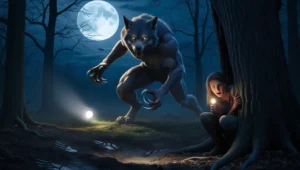The Chupacabra (Spanish for “goat-sucker”) is one of the most infamous cryptids in modern folklore. Since the 1990s, reports of this creature—described as a reptilian, alien-like beast with spines and glowing eyes—have spread from Puerto Rico to the Americas. But is there any truth behind the legend?
This guide examines:
✔️ The origins of the Chupacabra myth
✔️ Most famous sightings & evidence
✔️ Scientific explanations
✔️ Could it be real?
1. The Birth of the Chupacabra (1995)
First Reported Attack – Puerto Rico
- In March 1995, farmers in Canóvanas, Puerto Rico, found eight dead goats with two puncture wounds on their necks and completely drained of blood.
- Eyewitness Madelyne Tolentino described a 3-4 ft tall creature with spikes, red eyes, and kangaroo-like legs.
- The media dubbed it “El Chupacabra”, sparking a wave of sightings.
🔹 Key Detail: The creature was initially linked to UFO sightings in Puerto Rico, adding to its “alien” mystique.
2. Chupacabra Sightings Across the Americas
A. Texas & the U.S. (Late 1990s–Present)
- 1996: A rancher in Cuero, Texas, claimed to find a hairless, dog-like creature killing livestock.
- 2007: A “blue-skinned Chupacabra” was shot in Blanco, Texas (later identified as a coyote with mange).
- 2014: A hairless, long-snouted animal was filmed in Texas (likely a raccoon or canine with severe mange).
B. Latin America (Mexico, Chile, Nicaragua)
- 1996: Nicaragua reported attacks on chickens and cattle.
- 2000s: Mexico had multiple “Chupacabra” carcasses found (most were dogs or coyotes).
🔹 Pattern: Most “Chupacabra” bodies turn out to be mangy coyotes, raccoons, or dogs.
3. What Does a Chupacabra Look Like?
Two Main Descriptions:
- Reptilian Alien-Type (Puerto Rico)
- Bipedal, spiked back, glowing red eyes, fanged teeth.
- Resembles a small T-rex or alien hybrid.
- Hairless Canine-Type (U.S. & Mexico)
- Four-legged, grayish-blue skin, elongated snout.
- Often a coyote or dog with severe mange.
🔹 Why the difference? The original Puerto Rican reports were more “alien,” while U.S. sightings lean toward mutated animals.
4. Scientific Explanations
A. Mange-Infested Animals
- Sarcoptic mange causes hair loss, thickened skin, and a grotesque appearance.
- Coyotes, dogs, and raccoons with mange are commonly mistaken for Chupacabras.
B. Mass Hysteria & Folklore
- After the 1995 Puerto Rico incident, similar reports exploded due to media hype.
- Psychological suggestion makes people interpret normal predators as monsters.
C. Misidentified Predators
- Owls, bats, or wild dogs can drain blood from livestock (though not completely).
- Feral hogs attack in ways that leave puncture-like wounds.
5. Could the Chupacabra Be Real?
Arguments For:
- Some Puerto Rican witnesses insist the creature was not natural.
- A few carcasses remain unidentified (though most are mangy animals).
Arguments Against:
- No credible DNA evidence of an unknown species.
- No clear evolutionary role—why would a blood-sucking predator evolve?
- Most “evidence” is debunked as hoaxes or misidentifications.
🔹 Verdict: The original Puerto Rican Chupacabra remains unexplained, but U.S. cases are almost always mangy animals.
6. The Chupacabra in Pop Culture
- Featured in TV shows (The X-Files, MonsterQuest).
- A staple of cryptozoology alongside Bigfoot and Mothman.
- Merchandise, movies, and urban legends keep the myth alive.
Final Conclusion: Myth or Reality?
- Puerto Rico’s original Chupacabra? Still a mystery—eyewitnesses insist it was real.
- U.S. & Latin American cases? Mostly mangy coyotes or dogs.
- Cultural impact? Huge—the Chupacabra remains a legend of modern folklore.
🩸 Do you think the Chupacabra exists? Or is it just a mangy coyote with a scary reputation?








